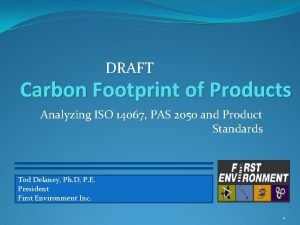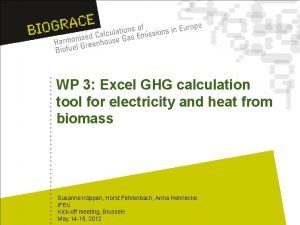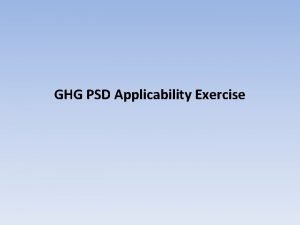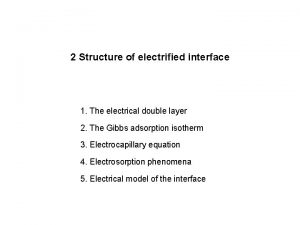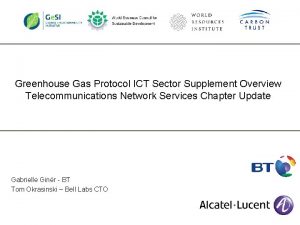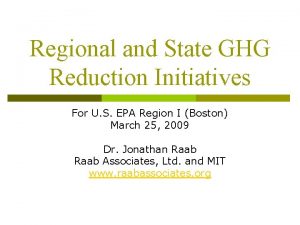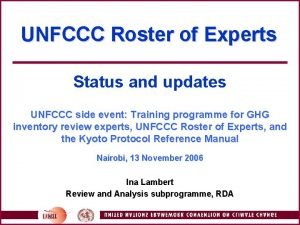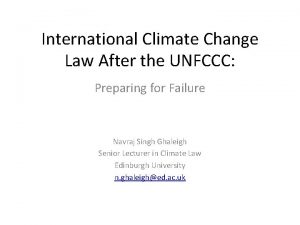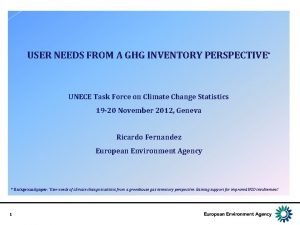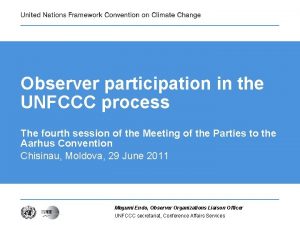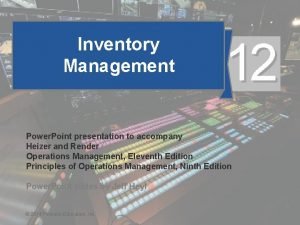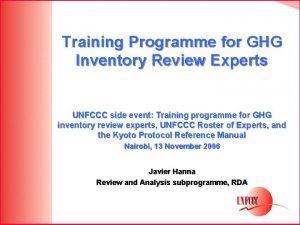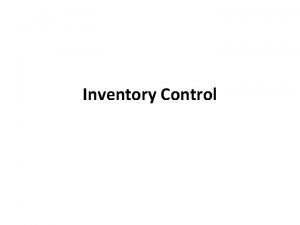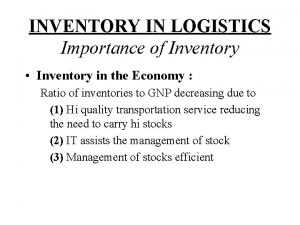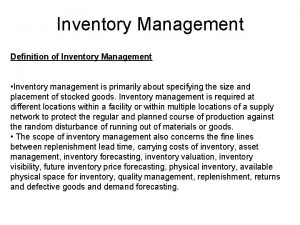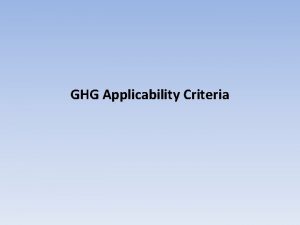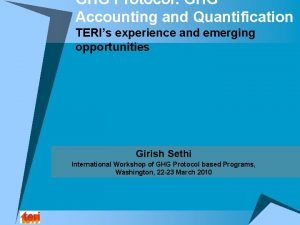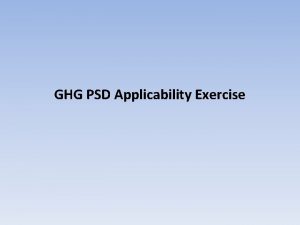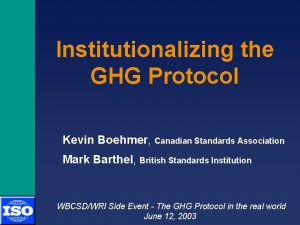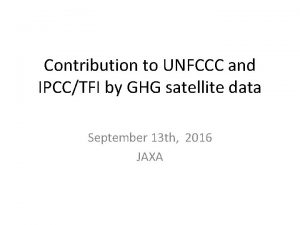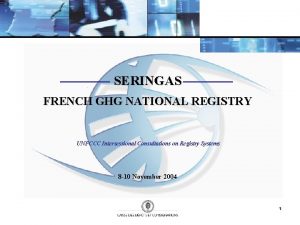Overview of UNFCCC training activities for GHG inventory


























- Slides: 26

Overview of UNFCCC training activities for GHG inventory review experts Roberto Acosta Inventories subprogramme, MIS UNFCCC secretariat Buenos Aires, 10 December 2004

Background (1) The guidelines for review under Article 8 of the Kyoto Protocol recognized the need for training of review experts, followed by a corresponding assessment of the trainee, stating: The training to be provided to experts, and the subsequent assessment after the completion of the training for participation in expert review teams shall be designed and operationalized in accordance with relevant decisions of the COP and the COP/MOP. The COP, by its decision 22/CP. 7 requested the SBSTA to design this training and to forward any draft decision on this issue to the COP and COP/MOP 1

Background (2) The SBSTA, at its 17 th session, requested the secretariat : • to organize a pilot training course on the review of GHG inventories, using traditional and e-learning methods. • to prepare a report on the experience gained during the pilot training course and, based on this experience, to prepare a proposal, including potential financial implications, for the development of a training programme necessary to ensure the competence of experts participating in review teams. • It decided to consider the report and the training proposal at its 18 th session.

Background (3) On the basis of SBSTA recommendations, the COP adopted two decisions on training of review experts (12/CP. 9: under the Convention and 21/CP. 9: under the Protocol) (See: FCCC/CP/2003/6/Add. 1 and Add. 2), which : • Request the secretariat to develop and implement a training programme for inventory ERT members, including testing of experts; • Encourage Annex I Parties to provide support; • Request SBSTA 24 to assess the results of the training programme and to recommend the COP and COP/MOP on further actions.

Background (4) The premises of the training programmes are similar under the Convention and the Protocol: • Successful trainees invited to participate in reviews with experienced experts; • All courses include examination, mainly during final seminar. Arrangements for taking exams at other times could be made, but under secretariat supervision. • Exams should be standardized, objective, transparent. • All courses available online or on CD ROM all year around. • Highly experienced review experts selected as instructors • Selection of trainees: Priority to experts from Parties whose experts have not participated in reviews before.

Background (5) The development and implementation of the training programmes depend on the availability of resources! • These resources do not come from the core budget, but from supplementary contributions. • The generous contributions of Switzerland, USA, Canada, Netherlands and Finland have allowed the results achieved in 2003 -2004. Japan, Netherlands and Spain have pledged additional contributions in 2004.

Background (6) Courses for review under the Convention: Course Description Target audience Format Exam/ / Seminar duratio n Review of Annex I GHG inventories Basic course LULUCF Covers IPCC and UNFCCC guidelines for preparation and review of GHG inventories. General module and five sectorspecific modules Based on IPCC good practice guidance Interact. 2 months Yes 50 experts, mainly those who Interact. have already 2 reviewed the months LUCF sector. Yes 30 new reviewers/ year Complementary skills of reviewers Improving communicatio Provides tools to improve the work of expert review teams Open to all reviewers Non Interact. Optional self check

Background (7) Courses for initial review under the Kyoto Protocol Course National Systems Application of adjustments Modalities for the accounting of assigned amounts under Article 7. 4 Description Covers guidelines for review of national systems under Article 5. 1 and related parts of guidelines under Articles 7 and 8 of the Kyoto Protocol Target audience Format Exam / duratio n Interact. 2 50 experienc months Required ed • to Covers COP decisions and reviewers, technical guidance on reviewers Interact. any of methodologies for adjustments who have these 2 under Article 5. 2 and related parts completed subjects months basic of guidelines under Articles 7 and 8 • For lead course, of the Kyoto Protocol reviewe lead rs Interact. Provides tools to improve the work reviewers 2 of expert review teams months

What has happened during 2003 -2004? (1) 1) Basic course - pilot training with final seminar in Geneva (organized by UNCTAD and UNFCCC secretariats) • The general module (on the use of the UNFCCC and IPCC guidelines/good practice guidance in the review process) available online for e-learning before the seminar. • 5 -days seminar (using power-point presentations) for sectorspecific modules and to take exams. • 28 experts participated; 20 passed the examinations; 19 new reviewers integrated in ERTs in 2003.

What has happened during 2003 -2004? (2) 2) All the other modules of the basic course (energy, fugitive, industrial processes, agriculture and waste) were converted to e-learning. 3) The course on improving communication among members of ERTs was developed and converted to e-learning. 4) All these modules/courses were made available on-line for reviewers all year round 5) The course on LULUCF review (using IPCC GPG LULUCF and new reporting requirements of decision 13/CP. 9) has been completed and the conversion to e-learning is almost ready.

What has happened during 2003 -2004? (3) 5) The second round of the basic training course has been completed with a final seminar in Bonn • General module and all sector-specific modules available online 1 -2 months before the seminar • 3 -day final seminar to practice inventory reviews and to take improved exams (see next slide) • 25 experts participated ; 21 passed examination; 20 new reviewers integrated ERTs in 2004

Improved examinations 1 st training (Geneva): • only true/false, multiple choice and interpretation questions + a sectoral part of an inventory submission to be reviewed when back home; • trainees did not know in advance the share of each question in relation to the rate to pass. 2 nd training (Bonn): • In addition, practical examples relating to the review of CRF/NIR and S&A tables with follow-up questions on identified inventory problems; • trainees knew in advance the share of each question These types of exams, plus seminars practicing reviews collectively under the guidance of instructors, facilitated a more effective incorporation of the new reviewers to the ERTs.

Other ways to conduct examinations Decisions 12/CP. 9 and 21/CP. 9 stipulated that other arrangements for examination (in addition to exams during seminars) will be made, provided that the examination take place under the supervision of the secretariat. In 2004, for the first time, two trainees passed successfully both exams (the general and the one of the sectoral module), after following the e-learning course, but without attending a seminar. (The exam was taken under the supervision of the secretariat and without cost for the secretariat). The trainees integrated successfully to the ERT work.

What is planned for 2005? (1) • Third round of basic inventory training – Basic course modules available online as of 3 January 2005 – final seminar in Tsukuba, Japan, mid-March 2005 (for 30 reviewers) • First training on LULUCF – Online 3 January 2005 – final Seminar in Valencia, Spain, mid-March 2005 (for 50 reviewers, mainly with previous LUCF review experience)

What is planned for 2005? (2) Development and possible implementation of the courses, subject to the availability of resources, included in decision 21/CP. 9 (KP) : – National systems reviews – Adjustments – Review of information on assigned amounts So far, thanks to a contribution of Finland a pledged contribution of Japan, funds exist for preparing the courses, but not for converting into e-learning or to organize a final seminar.

What is planned for 2005? (3) • Provide access to on-line e-learning courses (without interaction with instructors) to trainees that will opt to pass exams without attending final seminar, under the following premises: - trainees are nominated to the ROE - the Party will support her/his participation in review activities when needed - there is not an obligation by the secretariat to integrate a successful trainee into ERTs, if it is not possible because of balance considerations - the exam will take place under the supervision of the secretariat and will not imply any additional cost for the secretariat.

What is planned for 2005? (4) • Increase the interaction of the instructors with the trainees during the e-learning phase to detect weaknesses and work on them before the seminar • Carry out a regular assessment of the performance and efforts (see next slides) of the trainees during the e-learning phase to facilitate this interaction… and to take full advantage of the possibilities of e-learning • Keep the rigour of the examinations, and slightly increase it for those trainees that will not interact with instructors and attend seminars.

Monitoring and assessment of performance (1) Instructor tools • Performance of group and individuals – Number of logins – Online time – Quizzes/self-checks • Course evaluation by students Accesible any time to secretariat and instructors

Monitoring and assessment of performance (2) Number of logins

Monitoring and assessment of performance (3) Online time

Monitoring and assessment of performance (4) Quizzes

Monitoring and assessment of performance (5) Quizzes

Course evaluation by students • At the end of every online course, students are asked to complete a survey • Students are encouraged to give feedback and suggestions on experiences and opinion on training course.

Summary (1) • The training programme has been instrumental for a better preparation of the review experts and for a better performance of ERTs. • E-learning approach has demonstrated to be very useful for the preparation of new reviewers, for consultation and for consolidation of knowledge by the pool of reviewers. • The exams applied in the 2004 basic course are standardized, objective and transparent. • The rigour of examinations is an important element for a satisfactory performance of the trainees in the ERTs.

Summary (2) • At least 60 better prepared new reviewers will integrate into ERTs in 2005, increasing the pool of reviewers up to around 160. • 33 experts from Parties whose experts have not participated in the review activities up to 2002 will integrate into ERTs in 2005 (30 of them from Non-Annex I Parties). • Total number of Parties providing experts will have increased from 51 in 2001 to 95 in 2005. • Total number of non-Annex I Parties providing experts will have increased from 26 in 2001 to 57 in 2005.

Summary (3) • Reviewers of LUCF sector in years 2001 -2004 will update their knowledge to review using GPG-LULUCF and decision 13/CP. 9. • It is expected that many inventory reviewers of the precommitment period report will be trained to review national systems and information on assigned amounts, and on adjustments. • Decisions 12/CP. 9 and 21/CP. 9 are being implemented in a timely manner thanks to the support received from Parties.
 Pas2050
Pas2050 Ghg protocol ict sector guidance
Ghg protocol ict sector guidance Ghg calculator excel
Ghg calculator excel Ghg exercise
Ghg exercise Structure of electrified interface
Structure of electrified interface Ghg protocol ict sector guidance
Ghg protocol ict sector guidance U.ghg
U.ghg Ghg protocol revised
Ghg protocol revised Unfccc roster of experts
Unfccc roster of experts Unfccc annex 1 countries
Unfccc annex 1 countries What is the unfccc
What is the unfccc Unfccc
Unfccc What is the unfccc
What is the unfccc Unfccc 2020
Unfccc 2020 Megumi endo unfccc
Megumi endo unfccc Unfccc 2020
Unfccc 2020 Operating activities vs investing activities
Operating activities vs investing activities Indoor sports outdoor sports
Indoor sports outdoor sports Primary and support activities
Primary and support activities Examples of primary activities
Examples of primary activities Inventory management training ppt
Inventory management training ppt Fspos
Fspos Typiska novell drag
Typiska novell drag Nationell inriktning för artificiell intelligens
Nationell inriktning för artificiell intelligens Vad står k.r.å.k.a.n för
Vad står k.r.å.k.a.n för Varför kallas perioden 1918-1939 för mellankrigstiden
Varför kallas perioden 1918-1939 för mellankrigstiden En lathund för arbete med kontinuitetshantering
En lathund för arbete med kontinuitetshantering
